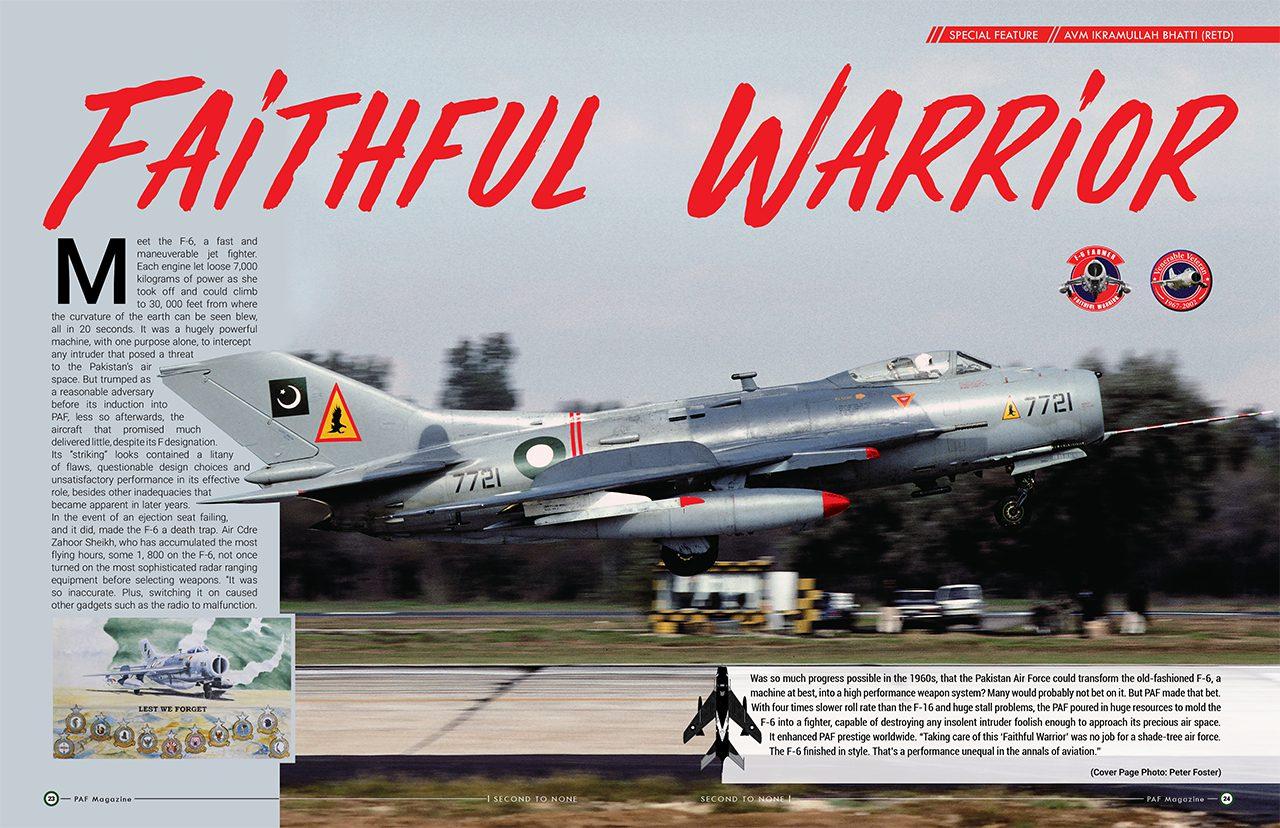Meet the F-6, a fast and maneuverable jet fighter. Each engine let loose 7,000 kilograms of power as she took off and could climb to 30, 000 feet from where the curvature of the earth can be seen blew, all in 20 seconds. It was a hugely powerful machine, with one purpose alone, to intercept any intruder that posed a threat to the Pakistan’s air space. But trumped as a reasonable adversary before its induction into PAF, less so afterwards, the aircraft that promised much delivered little, despite its F designation. Its “striking” looks contained a litany of flaws, questionable design choices and unsatisfactory performance in its effective role, besides other inadequacies that became apparent in later years. In the event of an ejection seat failing, and it did, made the F-6 a death trap. Air Cdre Zahoor Sheikh, who has accumulated the most flying hours, some 1, 800 on the F-6, not once turned on the most sophisticated radar ranging equipment before selecting weapons. “It was so inaccurate. Plus, switching it on caused other gadgets such as the radio to malfunction. For some reason, no one ever bothered to fix it,” he said. Yet this jet soldiered on for the next 35 years after induction only to become a potent symbol of PAF air power. Its ground up 130 plus modifications to transform the F-6 into a weapon system boasted of PAF greatness and ability in teaching the world that it is best at modifying planes. So grab a cup of tea as you read about the F-6, which your father and grandfather flew to war.
Origin of F-6
The F-6 story began almost 55 years ago at the height of the Cold War. The F-6, or in fact Mig-19, was the first supersonic fighter aircraft of the Soviet Union. The Chinese called their licence produced Mig-19s as J-6. Its export version was named F-6. And NATO code named it, the “Farmer”. During this era of the cold war, military technology developed at a rapid pace. Mig-15, the veteran of Korean War and Mig-17 that it developed into, were two of its precursors. The Mig-19 was the first mass produced supersonic aircraft in the world. It was designed in the early fifties and went into mass production in 1955. The rushed growth and developments in the Soviet military aviation industry soon led to the emergence of another far better fighter aircraft in 1956, the Mig-21. The Soviets thus stopped the production of Mig-19 in 1960. The Chinese had begun the licensed production of their J-6/F-6 in 1959. Owing to slower development in their aviation industry, a relative resource crunch and urgent requirements, they continued its production till 1981.
PAF Selects the F-6
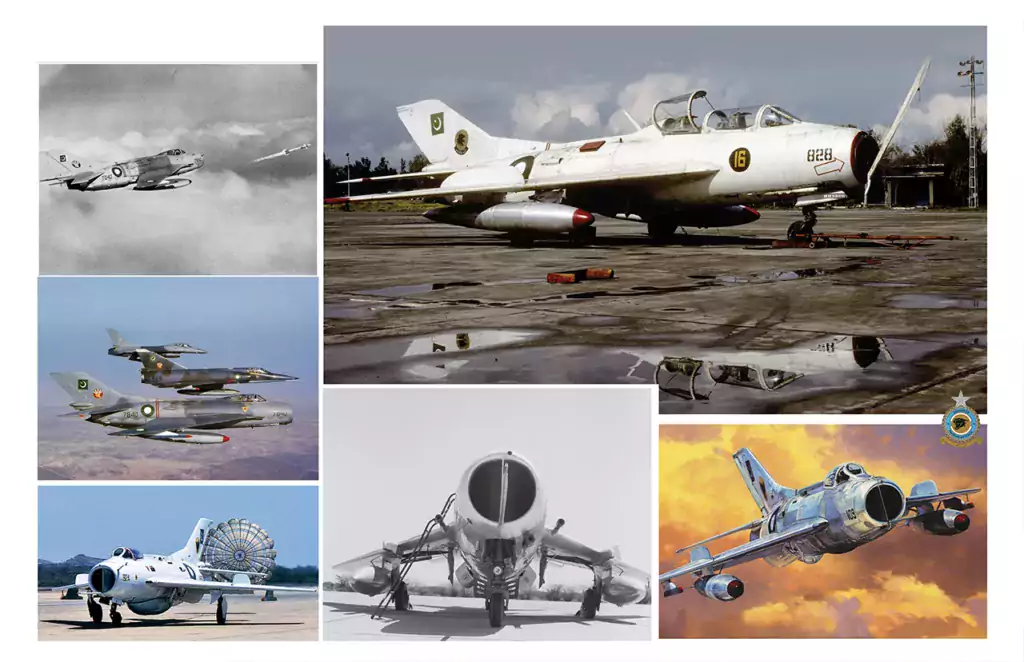
Soon after the start of 1965 war, USA put an embargo on sale of weapons to both Pakistan and India. India did not have any significant military hardware of US origin, hence the embargo was to effect Pakistan only. Sensing an impending crunch, the military planners of Pakistan quickly diversified their sources of military hardware. PAF was the hardest hit by this embargo. As such, the acquisition of F-6 fighter aircraft from China was a timely, logical and cost effective choice.
A contingent of around 60 personnel were sent to China in October, 1965. The members consisted of pilots, engineers and technicians. It was a clandestine operation. They travelled via Ceylon and Canton as civilians and did not wear uniforms throughout their stay at a training facility close to Beijing.
The training was challenging. All the books and technical manuals were in Chinese language and all that these people could gather were their notes in English. Everyone had his own understanding and noted as he understood. This resulted in a lack of standardization both in engineering and operational practices, which continued in the initial few years of F-6 operations in the PAF. Later, PAF personnel had to learn Chinese, which subsequently helped in understanding and developing standardized training and working manuals.
Ferry Flights
The delivery of the initial batch of 75 F-6s from China began in Dec 1965. Ferrying from Hotian, China, Wg Cdr Sadruddin and Flt Lt Khalid Iqbal landed the first two F-6s at PAF Base Sargodha (now Mushaf Air Base) on the afternoon of 20th December. They were the lead element of 12 F-6 aircraft that had taken off from Hotian that day in a discreet operation. No one knew at Sargodha that an F-6 ferry was to happen that day but when the formation arrived there was a huge gathering at the base, ready for the reception. A large number of F-6s were also shipped from China in crates. They were assembled at PAF Base Faisal and flown up country to Sargodha. The ferry operations from the neighbouring country were conducted over the next 15 years. The last ferry operation was undertaken in 1980. All ferry operations were undertaken from Hotian, a small town in western China on the edge of Taklamakan desert. The ferry itself was an exciting flight that included the challenge of crossing the Himalayas. Weather was the most serious consideration in these operations besides terrain. Sandstorm and thunder clouds were a frequent phenomenon. The weather forecasting services were not quite developed at that time. As such PAF’s C-130 transport aircraft was used for weather reporting and radio relay. Pilots had to be appropriately dressed for crossing over the snow covered mountains and briefed for all untoward situations. The excitement of crossing over the Himalayas, seeing the K-2 and the relief of seeing the river Indus still lives in their memories.
F-6 in PAF Service
How an aircraft that did a 90 degrees turn in a second, compared with an F-16 that does a 360 in same time, could survive, let alone fight, was one of the enduring mysteries. In all, a terrifying 260 were inducted from 1966 to 1980 to equip ten of its fighter squadrons. No 23 Squadron was the first PAF fighter squadron to be equipped with F-6 aircraft on 8th Feb 1966, an interestingly was also the last to bid farewell to this faithful warrior. The F-6 was not built for the faint hearted. It was a real stick and rudder type flying, often unresponsive at low speeds. No matter how many hours pilots had in it, this jet kept finding ways to challenge them. “Still, the F-6 was a pilot’s airplane. You could feel the aircraft talking to you through all those manual controls. We used to feel part of this jet. It pushed us to become better,” said Air Cdre Amjad Bashir, veteran pilot of F-6. The air force operated the F-6 without a dual seat trainer until 1980. It relied on UMig-15 for initial conversion and instrument training.
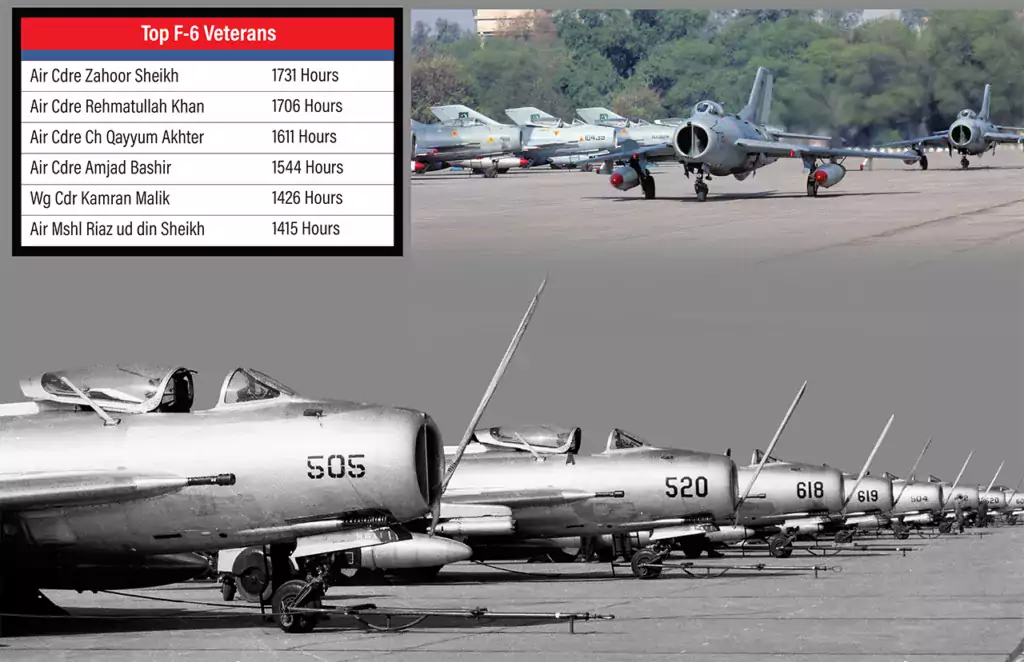
Along with this, the absence of a flight simulator was another serious impediment in standardised training, in familiarizing controls and to practice basic cockpit procedures and emergency drills. This was indeed a challenging time. The F-6 was a more challenging machine to fly compared with modern planes that have carefree handling, said
Air Cdre Amjad Bashir. “It involved intense pilot workload. Simply put, it separated men from boys. Hence for its first ten years, the F-6 was treated with caution and respect until pilots gained more operational and technical experience on it. Initially, it was an exclusive club open only to experienced fliers who were converted to this aircraft. However, with the phasing out of F-86s and having flown the F-6 for a decade, in 1976, PAF started inducting new graduates from Fighter Conversion Unit on to F-6. It was a well thought out undertaking, although strewn with anxious moments.
The F-6’s twin engines could develop more than 15, 000 lbs of thrust each, punching the F-6 higher than Mt Everest in a matter of seconds. To produce that incredible engine thrust meant massive fuel consumption. To put it in layman terms the average car fuel tank will be empty in 5 seconds in this machine. High fuel consumption and a relatively lesser fuel capacity restricted the flight time of the F-6. The sortie duration varied between 25 to 55 minutes depending upon the fuel configuration and type of mission. Pilots had to prudently plan their use of after burner (AB) in air combat missions. Just five minutes of AB use would force the pilot to start looking at the fuel gauge and begin thinking of his recovery. The concept of energy manoeuvrability had “fuel in the tanks” a much higher premium for F-6 pilots besides “height” and “speed”. The Air Traffic Controllers (ATCOs) of 70s and 80s recall that among all fighter aircraft of the PAF the F-6 had the maximum episodes of landing with minimum fuel. PAF, therefore, had attempted to increase fuel capacity of F-6. A gondola (under belly) integral fuel tank was fitted like the British Lightning aircraft. But this did not succeed. Bigger drop tanks were also introduced, which did increase the fuel capacity but at the cost of manoeuvrability of the F-6. With a higher weight and drag and lower “Gs” limit, these tanks were good only for ground attack or ferry flights.
Despite possessing a cuddly aesthetic, the F-6 was a killer. It was not an easy jet to shoot down even though in the absence of an on-board air-to-air radar, the air combat in an F-6 had to be visual. Whosoever, gained sight of the adversary first had higher chances of success as he could execute his planned tactic first and achieve surprise. The concept of HOTAS (hands on throttle and stick) had not come into vogue by that time and pilots had to lift their left hand from the throttle to manipulate vital switches and buttons. A popular piece of advice at the time from the F-6 veterans to the younger pilots was “Lose sight lose fight”. Pilots could not afford to look inside during crucial moments of air combat. Hence they had to know the F-6 cockpit like the back of their hands. All the cockpit switches, lights, indicators and gauges were marked in Chinese. While the F-6 RF (Rebuild Factory at Kamra) had broken into the writing technique of Chinese cockpit lights by placing appropriately captioned negative films under the light cover, special decals had to be made in English to read the instruments and controls correctly. PAF had several types of fighter aircraft in its inventory. Pilots in instructional, command or staff positions flying the western aircraft concurrently had to be watchful in cockpit drills while flying the F-6. There was the training regimen of blindfold cockpit checks. The experienced pilots could easily select the desired weapon, operate flaps, select and deselect the military or AB setting of the engine with their eyes glued to the adversary. This was their secret of success besides experience and confidence to maneuver the F-6 at low speeds with flaps and rudders.
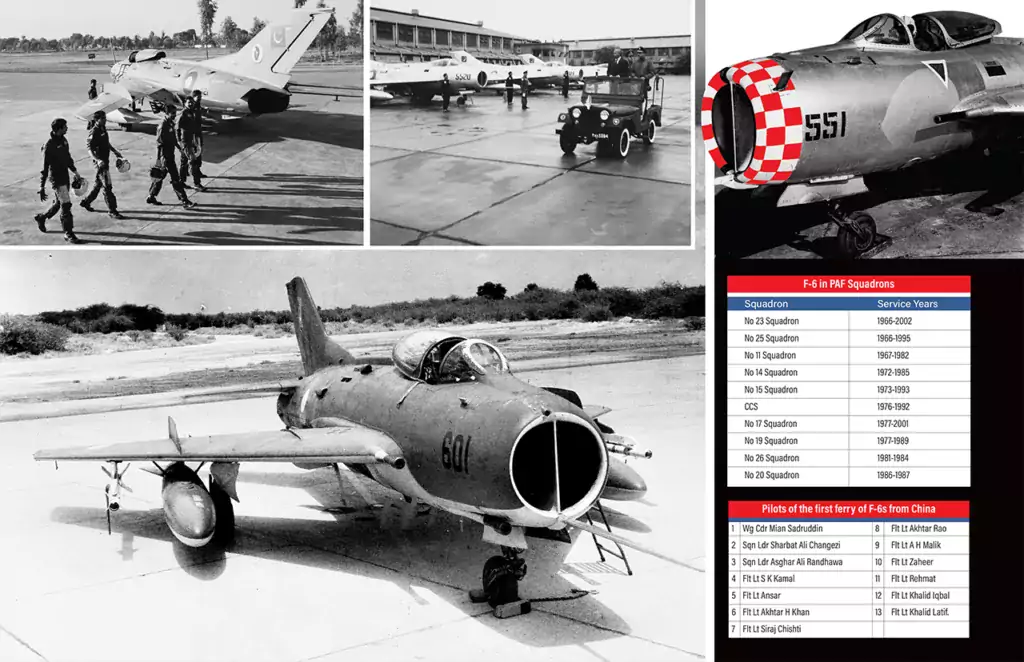
The only on-board nav-aid on the F-6 was the basic radio compass which, for reasons, would readily become erratic with the appearance of clouds. So the F-6 pilots had to memorise maps and know their flying areas well. “Local and General Lost Procedures” were an important part of the flying protocols. Periodic drills of recovery through radar assistance were routinely practiced to not only keep the skills of the radar controllers honed but to also give confidence to the F-6 pilots. Despite all this the incidents of F-6 pilots getting unsure of their ground position were not uncommon. “Imagine how much faith you must have in yourself, in your skills and in the plane to do something like that on a daily basis. This is besides the fact that it took sheer guts to control this beast,” Gp Capt Mansoor Mehmood quipped.
Luckily the limited range of the F-6 would not let fliers go too far astray from their intended tracks. In any case, during cross country flights, the weather brief and arranging a “Flight Following Service” with the area radar were mandatory. All these peculiarities let the F-6 pilots develop and maintain good relations with the radar controllers. This became handy and useful during dissimilar air combat training as the F-6 pilots got to know their radar controllers well and had confidence in them.
Somewhere in December 1965 PAF also received five Russian Mig-19 aircraft from Indonesia. These aircraft were ex Indonesian Air Force and were in addition to other military hardware received from Indonesia. This was a result of a close friendship between President Sukarno and President Ayub Khan. These aircraft were shipped in crates and assembled at PAF Base Masroor.
F-6 Rebuild Factory Kamra
F-6 had a rather limited time between overhaul both for engine and airframe. During the first 15 years of its service the aircraft used to be ferried to PAF Base Faisal. There it was disassembled and packed in crates for shipment to China. They were received after overhaul in the same manner and then flown off to respective bases after reassembly. Besides being expensive, this arrangement denied the PAF the availability of the aircraft for up to two years. Work began in 1977, for developing an in-country overhaul facility. Eventually on 8th Nov 1980, F-6 rebuild Factory was inaugurated at Kamra and it rolled out the first overhauled F-6 tail number 7112 on 10th Nov 1981. The second and third were rolled out in February and April 1982. These first three F-6s were overhauled and test flown by the Chinese at the MRF with PAF engineers and technicians learning on the job. The fourth F-6, tail number 1913, was completely overhauled by PAF. It was air tested in September 1982. Being the first ever attempt at overhaul by the PAF, the pilots were a bit sceptical. Kamra at that time had not been commissioned as a proper air base and only had a bare bone infrastructure. Needless to say that the air test was a success in the first attempt. Besides the performance of the aircraft, the test pilot, Flt Lt Nusratullah Khan, was quite excited on seeing all light covers with captions in English. He enthusiastically admitted, “It is the first time I have come to know what most of these lights are for!” There was no looking back thereafter. In all, the F-6 RF overhauled 223 F-6 aircraft and carried out major repairs on 133 of them.
The F-6 RF not only kept the operational availability of F-6s high, it also came in handy for incorporating various important modifications. PAF reportedly made around 140 modifications on the F-6 to suit it’s operational and safety requirements. The retrofit of American Sidewinder missiles was the first major modification carried out on the F-6. In the sixties and early seventies the other combat aircraft in PAF inventory had reliable ejection seats. However, design deficiencies and performance limitations in the Chinese ejection seat became a serious concern among the pilots. Taking cognizance of this urgent issue PAF in 1975, eventually installed a customised Martin Baker ejection seat in the F-6s, which was a great source of confidence to the F-6 pilots. The other significant mods included AIM-9B/J/P, MM3 attitude indicator, Western altimeter in feet, UHF Radio, Gun Camera, ECCM mod, L/G beeper and IFF/SIF etc.
F-6 in Combat Operations
The F-6 became a legend in its own lifetime in the Pakistan Air Force. By the time the 71 war loomed, PAF had operationalised three squadrons of the F-6. The pilots of No 11, 23 and 25 squadrons were those who had extensive prior experience on the F-86s. When the war broke out these pilots had also acquired enough training and experience on the F-6 in air defence and ground support roles. The retrofit of Sidewinder missiles had given them a lot of confidence. They were quite familiar with this weapon and had developed full confidence in their well-armed F-6 aircraft, flying it down to fine art. F-6s flew combat air patrols and were also employed for ground attack. On the whole, they flew over 650 air defence sorties and claimed seven confirmed kills in aerial combat including Mig-21, Hunter and SU-7 aircraft. The F-6s also rendered valuable support to our ground troops. They flew 184 ground attack sorties destroying enemy tanks, vehicles, bunkers and troop concentrations. Their ground attack role in Shakagarh sector was considered to be most successful.
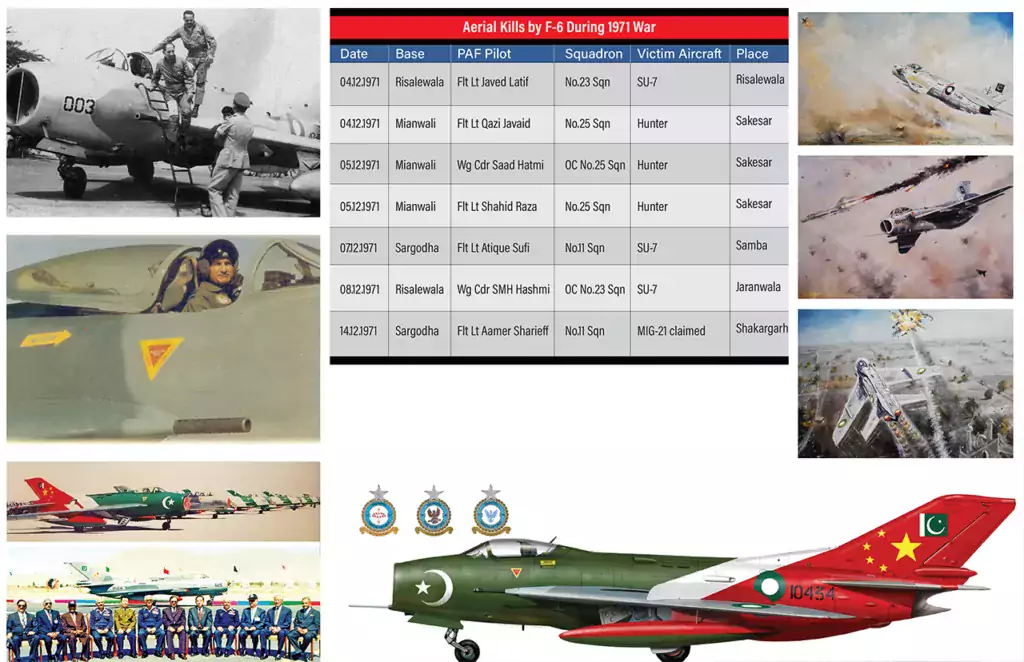
As Pakistan’s nuclear programme matured in early and mid-eighties, military planners sensed an impending aerial threat against it. This warranted dedicated air defence of facilities at Kahuta. F-6s along with Mirages, fully participated in this campaign of the PAF and shouldered a major share of this responsibility. After the Soviet invasion of Afghanistan as Afghan/Soviet combat aircraft began operations against the Mujahideen, their incursions into Pakistani airspace increased. Operating from Peshawar and Samungli (Quetta)F-6s provided an effective defence of Pakistan’s western borders. The four squadrons of F-6s, based two each at Peshawar and Samungli, contributed 60 % to the air defence effort of the PAF against the Soviet/Afghan incursions. Also, when in 1998 Pakistan was to test its nuclear weapons at Chagai, Baluchistan, PAF Base Samungli was the closest to this site. Hence, F-6s provided the bulk of the effort for the air defence of the test site.
The acquisition of F-6 by PAF was the foundation of Sino-Pak relationship that has strengthened over the subsequent years. The F-6 was replaced by the Chinese F-7PG, an upgraded version of the F-7P that was already in PAF inventory. The prolonged successful presence of F-6 in PAF inventory was a testimony to the friendship that Pakistan and China have had. Since the launching of the F-6 programme PAF has moved on to K-8, F-7P, F-7PG, ZDK-03 AWACS and finally the JF-17. Acquisition and joint development of these aircraft along with several weapons and sensors has strengthened the strategic relationship between the two countries. This legacy has opened the ways for new and more important and beneficial venues for Pakistan and PAF in the field of military aviation.
F-6 was a conventional aircraft that required pilots to have true knowledge and understanding of its aerodynamic peculiarities and performance envelope. The sooner pilots acquired this acquaintance the earlier they would control and master this wild horse that had a mind of its own. F-6 could be tamed with the raw pilot ability of its fliers. As officers gained experience on the F-6 they began to like it more and more. Unlike the modern day fighter aircraft the F-6 had to be “flown” by its pilots and not “operated” by them. They were daredevils of the PAF, who chose to mount a maverick whose ride was thrilling, yet risky.
No 23 Squadron of PAF has had the unique association with F-6 aircraft. On 8th Feb 1966 this was the first Squadron to be equipped with F-6s and until 27th March 2002, it was the last squadron to have operated this aircraft – a long faithful bond of 36 years.
F-6 remained the mainstay of the PAF in the 70s and 80s till overtaken by the Mirage and F-7. During this time frame it rendered the extremely valuable service of keeping its fighter pilots skilled and operationally ready for them to subsequently move on to Mirages and F-16s. It kept the army FACs trained for close support operations and accomplished the all-important task of meeting nearly 80% of the air defence requirement of the PAF. It rendered valuable contribution in times of war and operational contingencies. Every fighter pilot of PAF who was in service in the 70s and 80s got an opportunity to fly the F-6. Despite its peculiarities and handicaps, the F-6 was a joy to fly but rather challenging to master. F-6 had uniquely striking looks. It was an aircraft that looked robust, muscular and virile and had many captivating profiles. F-6 operators will never forget their experience of having flown this unique and enchanting fighter aircraft.
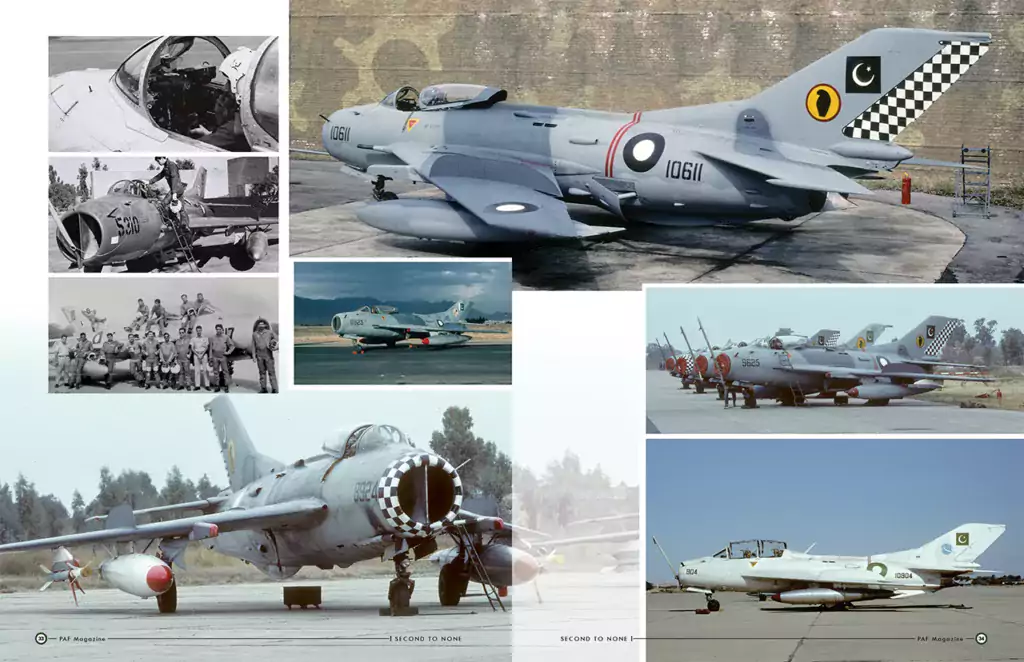
On 27th March 2002, Pakistan Air Force bid farewell to its work horse, the F-6, at PAF Base Samungli near Quetta, Baluchistan. F-6 made outstanding contributions to aviation and peace in the region. As such, it deserved a befitting farewell. The highlight of this occasion was an impressive fly past of a formation of all types of fighter aircraft of PAF with the F-6 in lead. The display also included a bomb burst by four specially painted green and white F-6s. Air Chief Marshal Mushaf Ali Mir, CAS PAF, hosted the event and Governor Baluchistan was the Chief Guest. The other highlight of the event was the presence of pioneers and old timers of the F-6 programme of the PAF, especially veterans of 71 war. Air Marshal Nur Khan, former C in C of the PAF, was the most notable among them. He was responsible for selecting and inducting the F-6 in the PAF. Chief of Staff of the Chinese PLA Air Force was also among the guests along with senior officials from the Chinese aviation industry.
“We flew a challenging aeroplane, but with their zest and skill, the pilots could take it to its limits and even beyond. Flying the F-6 always enhanced the fascination of fighter flying”, said Wg Cdr Kamran Malik, a veteran F-6 pilot.
